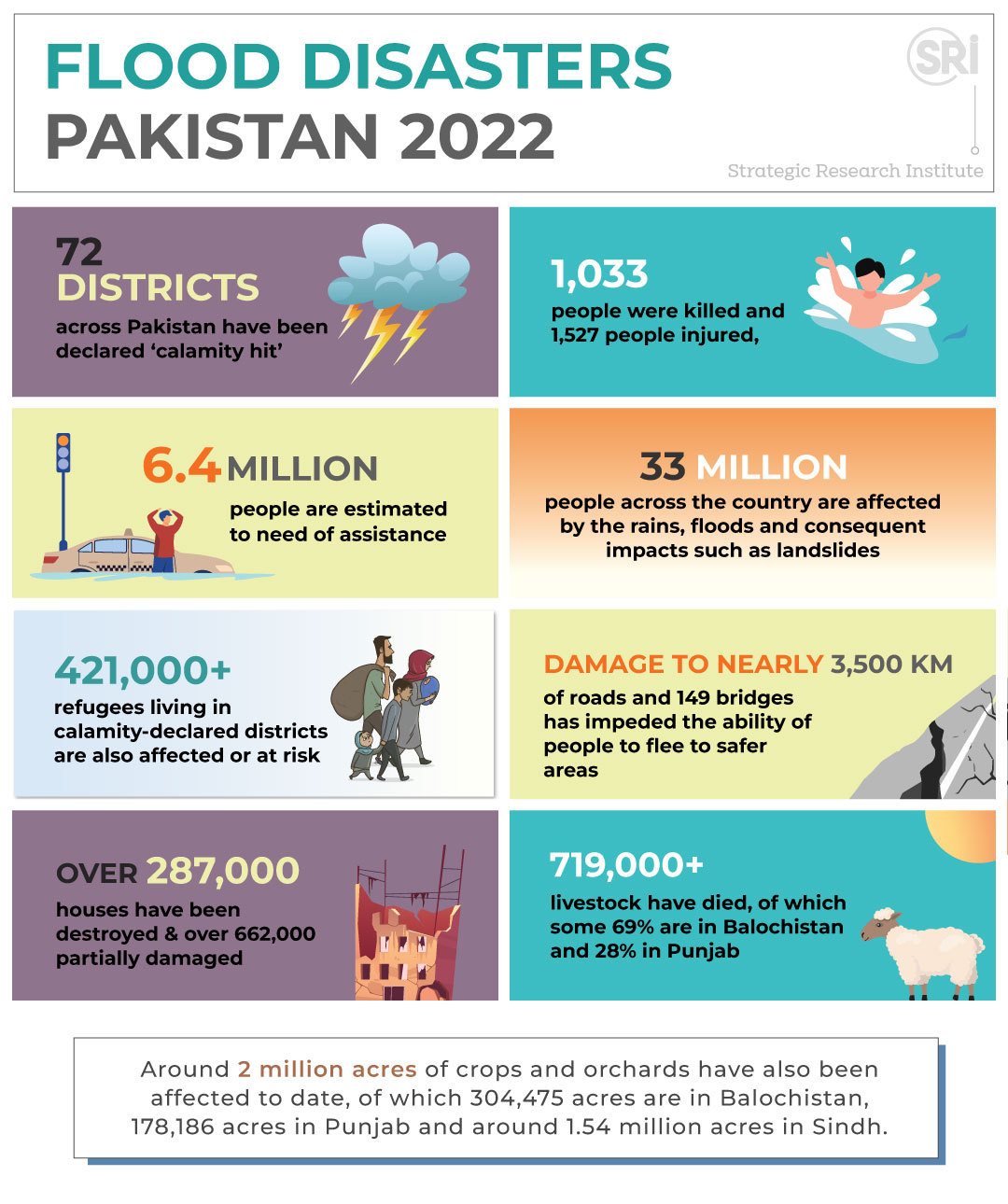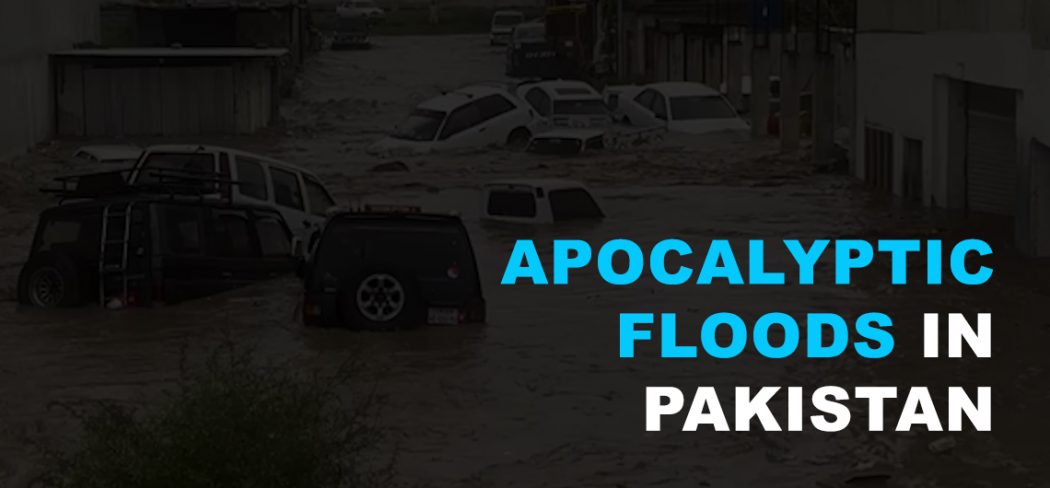The destruction of the Haiti earthquake and the Japan Tsumani combined was less than the damage caused by the 2010 flood in Pakistan. The flood was caused by the consecutive three days of monsoon rain that swelled the Indus river causing the flood water to move from the Himalayas, southwards to the Arabian Sea. 84 out of 121 districts were affected by the flood, causing 20+ million people out of 168 million to be hit by the flood, 1700+ people died, 7+ million were left homeless, 1.8 million homes were destroyed, 2.4 million hectares of standing crops were submerged and 450,000+ livestock was lost. Pakistan initiated the Pakistan Initial Floods Emergency Response Plan. Since then, over the years Pakistan has faced comparatively low levels of floods during the monsoon time. Certain forms of flood mitigation measurements were taken such as flood walls, flood gates, levees, and emergency evacuation routes.
However, all failed as soon as Pakistan again faced the natural calamity in 2022 where it faced 67% above the normal level of rainfall affecting more than 33 million people country-wide. Till now, 110 districts have been declared calamity hit, 1000+ people have died and 6.4+ million people are in need of assistance. This year’s flood has caused more destruction in Pakistan than any flood in history. The flood has been named Apocalyptc. UN Secretary-General, Antonio Guterres said that, “Pakistan is facing a monsoon on steroids” and that Pakistan is hit by a “Climate Crisis Hotspot”. So much so that climate change minister Sherry Reham has mentioned that one-third of Pakistan is under water. On August 31, 2022, NASA’s MODIS satellite images show a 100KM wide agricultural field turned into an inland lake caused by the overflow of the Indus River. There is no doubt that Pakistan is definitely amongst the top ten countries which are most vulnerable to the effects of climate change even though Pakistan is responsible for less than 1% of global carbon emissions. Global warming caused by a 1.2C rise in global temperature is responsible for extreme rainfall along with glacier melting and other destructive phenomena. Pakistan experienced a 0.6-degree rise in temperature which resulted in extreme heat waves causing multiple deaths and affecting hundreds of people. Jacobabad, Sindh hit 51C on the mercury making it the hottest city on the earth in mid-may. Not only this temperature rise also caused glacier melting, resulting in a change in precipitation pattern thus disturbing the whole water cycle. Looking at the other extreme, where we are currently living, Pakistan has faced 2.7 times more rainfall than the average rainfall in the last 30 years. Along with the rain, the water from glacier melting is also adding to the destruction.
There is no doubt that Pakistan is definitely amongst the top ten countries which are most vulnerable to the effects of climate change even though Pakistan is responsible for less than 1% of global carbon emissions. Global warming caused by a 1.2C rise in global temperature is responsible for extreme rainfall along with glacier melting and other destructive phenomena. Pakistan experienced a 0.6-degree rise in temperature which resulted in extreme heat waves causing multiple deaths and affecting hundreds of people. Jacobabad, Sindh hit 51C on the mercury making it the hottest city on the earth in mid-may. Not only this temperature rise also caused glacier melting, resulting in a change in precipitation pattern thus disturbing the whole water cycle. Looking at the other extreme, where we are currently living, Pakistan has faced 2.7 times more rainfall than the average rainfall in the last 30 years. Along with the rain, the water from glacier melting is also adding to the destruction.
To get an idea of the severity of displacements and the number of people affected by the flood in Pakistan it is immensely important to highlight that the people affected by floods are six times the people displaced in the recent Ukrainian war, around 90% of the population of Canada, 100% population of Australia and three times the population of Portugal. It is not to say that the Global North is immune to climate change-induced disasters, Europe and North America have seen a fair share of floods and fires, but the real setback is the North’s reluctance to reduce the use of fossil fuel because calamity does not directly hit them as it hits the low carbon emission countries.
Editorials: Flooding in Pakistan is More Than What It Seems
In compensation for the excessive carbon emission by the western world, the global south launched “relief funds for flood affectees” in Pakistan. But is it really enough? Statistically speaking the US decided to give aid of $30 Million for flood relief efforts and humanitarian assistance, which sounds huge in numbers but if we divide it amongst 33+ million affected people, it is less than a dollar for one person. The United States, a country with the second highest global carbon emission is compensating for the damage it is bringing to the world by giving less than a dollar to the affected people.
The excessive carbon emissions by the wealthier nations causing global warming and climate change have indeed put Pakistan at the forefront of climate change yet it will not be unfair not to say that the inaction by the government(s) of Pakistan over the years is equally responsible for what Pakistan is facing today. One cannot just call it a “Natural Disaster”, “Climate Change”, or “effects of Global Warming” and get done with it. As Asad Rehman, director of War on Want said that “Pakistan and other states in the developing world are stuck in a toxic interplay between a climate catastrophe that they’re not responsible for, increasing hunger, structural inequality, and a rigged economic system that has literally left the poor hanging by a thread”.
The repetitive governments of Pakistan need to take the responsibility for what is happening today majority in Balochistan, Sindh, KPK, and even in Punjab. Pakistan is drowning like it did in 2010 which was called once in a generation event yet 33 million people are affected. A significant problem that Pakistan has been a victim of for decades is corruption which flows down from the government officials to the hotel owners who built the hotel on encroached land with no check and balance. Just like in 2010, Pakistan might get enough charity to survive in these crucial times but the real question is when? How long will Pakistan continue to run on charities and aid from overseas Pakistanis and “friendly” countries? How long can Pakistan survive on the NGOs for the relief work? Is this not the time that Pakistan should finally come up with a flood mitigation system and basic ethos to make roads, bridges, and buildings enough good for them to survive a calamity?
Government after government in Pakistan lacks seriousness when it comes to the looming water crisis in the country. Environmentalists and water crisis experts have time and again reminded the countrymen that Pakistan requires numerous water storage infrastructures yet internal politics has always won over the crisis. The widespread deforestation to build new infrastructure for commercial purposes has added to the overflow of rivers. As already been mentioned there are no regulated customs of construction in flood-prone areas whether it is the new tourist attractions or a sewage system. For example, even the mainstream cities like Karachi is a victims of yearly urban flooding now. But the inter-party conflicts have always been superior to any natural calamity.
Read More: The never-ending Shadow of Calamities over Balochistan
In a Picture: Pakistan’s catastrophic flood
Follow us on Facebook for quick Updates.









